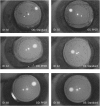Impact of primary posterior capsulorhexis on regeneratory after-cataract and YAG laser rates with an acrylic micro-incision intraocular lens with plate haptics: 1-year and 3-year results
- PMID: 31197967
- PMCID: PMC6899841
- DOI: 10.1111/aos.14156
Impact of primary posterior capsulorhexis on regeneratory after-cataract and YAG laser rates with an acrylic micro-incision intraocular lens with plate haptics: 1-year and 3-year results
Abstract
Purpose: To evaluate the posterior capsule opacification (PCO) and YAG laser capsulotomy (YAG-LCT) rates with a plate-haptic acrylic micro-incision intraocular lens (IOL) and the impact of primary posterior capsulorhexis.
Methods: A total of 97 patients scheduled for immediate sequential bilateral cataract surgery underwent a randomized, prospective intraindividual comparison with the ZEISS Asphina 409MV plate-haptic acrylic IOL with the eyes receiving an additional primary posterior capsulorhexis (PPCR) or not. YAG-LCT and PCO rates were evaluated at 1 and 3 years. Three-year PCO rates were calculated with a 3-scenario method for eyes that underwent YAG-LCT between 1 and 3 years.
Results: A total of 56 patients were seen at 1 year, and 57 at 3 years. For the eyes without and with PPCR, YAG-LCT rates were 14.3% and 0% at 1 year, and 59.7% and 3.5% at 3 years, respectively. Opacification rates at 1 year were 0.55 ± 0.99 and 0.05 ± 0.21 for the central 2-mm optic zone. A total of 42 patients completed both the 1- and 3-year follow-up. Three-year opacification rates for the group without PPCR were 1.99 ± 2.20, 2.26 ± 2.66 and 3.66 ± 3.61 for the central 2-mm zone and 2.57 ± 2.07, 3.13 ± 3.03 and 4.09 ± 3.34 for the 4.5-mm zone for the best, extrapolated and worst-case scenarios, respectively.
Conclusion: The ZEISS Asphina 409MV plate-haptic acrylic IOL exhibited unusually high YAG-LCT and PCO rates with standard in-the-bag implantation. PPCR was safe and effective in preventing central opacification and the need for YAG laser treatment.
Keywords: YAG laser capsulotomy; ZEISS CT Asphina 409MV plate-haptic acrylic micro-incision intraocular lens; posterior capsule opacification; primary posterior capsulorhexis.
© 2019 The Authors. Acta Ophthalmologica published by John Wiley & Sons Ltd on behalf of Acta Ophthalmologica Scandinavica Foundation.
Figures




Similar articles
-
Update on fixation of rigid and foldable posterior chamber intraocular lenses. Part II: Choosing the correct haptic fixation and intraocular lens design to help eradicate posterior capsule opacification.Ophthalmology. 1999 May;106(5):891-900. doi: 10.1016/S0161-6420(99)00506-0. Ophthalmology. 1999. PMID: 10328386
-
Effect of primary posterior continuous curvilinear capsulorhexis on clinical performance of ACR6D SE single-piece hydrophilic acrylic intraocular lenses.J Cataract Refract Surg. 2007 Apr;33(4):628-34. doi: 10.1016/j.jcrs.2007.01.007. J Cataract Refract Surg. 2007. PMID: 17397735 Clinical Trial.
-
Posterior capsule opacification and neodymium:YAG laser capsulotomy rates with a round-edged silicone and a sharp-edged hydrophobic acrylic intraocular lens 10 years after surgery.J Cataract Refract Surg. 2009 Mar;35(3):459-65. doi: 10.1016/j.jcrs.2008.11.044. J Cataract Refract Surg. 2009. PMID: 19251138
-
Posterior capsulorhexis combined with optic buttonholing: an alternative to standard in-the-bag implantation of sharp-edged intraocular lenses? A critical analysis of 1000 consecutive cases.Graefes Arch Clin Exp Ophthalmol. 2008 Jun;246(6):787-801. doi: 10.1007/s00417-008-0779-6. Epub 2008 Apr 19. Graefes Arch Clin Exp Ophthalmol. 2008. PMID: 18425525 Free PMC article. Review.
-
Efficacy of different intraocular lens materials and optic edge designs in preventing posterior capsular opacification: a meta-analysis.Am J Ophthalmol. 2007 Mar;143(3):428-36. doi: 10.1016/j.ajo.2006.11.045. Epub 2006 Dec 28. Am J Ophthalmol. 2007. PMID: 17224119
Cited by
-
Primary Posterior Continuous Circular Capsulorhexis without the Use of Ophthalmic Viscosurgical Device.Clin Ophthalmol. 2023 Feb 2;17:441-444. doi: 10.2147/OPTH.S386925. eCollection 2023. Clin Ophthalmol. 2023. PMID: 36755891 Free PMC article.
-
Effect of surface-modified intraocular lenses on long-term postoperative inhibition of posterior capsule opacification.Heliyon. 2024 Jun 14;10(12):e33006. doi: 10.1016/j.heliyon.2024.e33006. eCollection 2024 Jun 30. Heliyon. 2024. PMID: 39022042 Free PMC article.
-
How do intraocular lens materials influence the outcome of cataract surgery?Curr Opin Ophthalmol. 2025 Jan 1;36(1):18-24. doi: 10.1097/ICU.0000000000001095. Epub 2024 Oct 23. Curr Opin Ophthalmol. 2025. PMID: 39446645 Free PMC article. Review.
References
-
- Buehl W, Heinzl H, Mittlboeck M & Findl O (2008): Statistical problems caused by missing data resulting from neodymium: YAG laser capsulotomies in long‐term posterior capsule opacification studies: problem identification and possible solutions. J Cataract Refract Surg 34: 268–273. - PubMed
-
- Faschinger CW & Eckhardt M (1999): Complete capsulorhexis opening occlusion despite capsular tension ring implantation. J Cataract Refract Surg 25: 1013–1015. - PubMed
-
- Findl O, Buehl W, Menapace R, Georgopoulos M, Rainer G, Siegl H, Kaider A & Pinz A (2003): Comparison of 4 methods for quantifying posterior capsule opacification. J Cataract Refract Surg 29: 106–111. - PubMed
-
- Georgopoulos M, Menapace R, Findl O, Rainer G, Petternel V & Kiss B (2001): Posterior continuous curvilinear capsulorhexis with hydrogel and silicone intraocular lens implantation: development of capsulorhexis size and capsule opacification. J Cataract Refract Surg 27: 825–832. - PubMed
-
- Leydolt C, Kriechbaum K, Schriefl S, Pachala M & Menapace R (2013): Posterior capsule opacification and neodymium:YAG rates with 2 single‐piece hydrophobic acrylic intraocular lenses: three‐year results. J Cataract Refract Surg 39: 1886–1892. - PubMed
Publication types
MeSH terms
Substances
LinkOut - more resources
Full Text Sources

